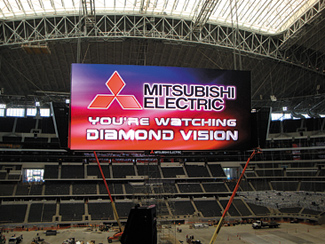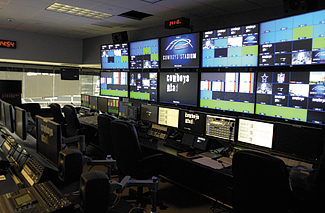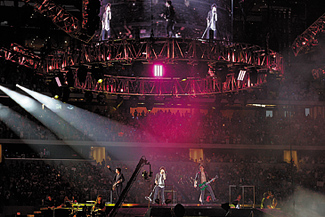Big D Simulcast

ARLINGTON, TEXAS Cowboys Stadium, the new home to one of the NFL's premier teams, opened to the public on June 6, giving fans a great view from every angle.
"Our new stadium will be an entertainment destination," said Jerry Jones, owner and general manager of the Dallas Cowboys. His goal, he said, was "delivering an entirely new type of immersive fan experience with the latest cutting edge technology."
The price tag? $1.1 billion. Jones believes that's what it takes to get 80,000-100,000 folks to leave their 50-inch plasma screens for this 3 million square-foot arena.
A four-sided, 72-foot tall, 160-foot long Mitsubishi Diamond Vision 1080i HD display is suspended 90 feet directly over the center of the playing surface. What fans will be able to see on the screens is truly tailored to the audience.
INSIDER'S VIEW
The size of the screen—at the moment, tagged as the world's largest HD LED display—is just one element of the technology that went into its development. "The really interesting aspect of the board is the reverse angle—we're able to flip the image," said Scott Purcel, director of broadcasting for the Dallas Cowboys.
For example, the video screen for fans sitting on the side of the field away from the action will alter the direction of play so that they will see the players run in the same direction in the video as they are running on the field.

The new 3-million square foot Cowboys Stadium opened to the public last month. "We have multiple control rooms, multiple switchers, multiple graphics images to actually produce two shows at the same time," said Purcel. "We have the ability to take any feed from the network cameras, plus three of our own in-house cameras and put them up on the board, and then from the opposite side of the field, more cameras that will be able to do a reverse image."
Video is also tailored to fans seated near the end zones.
"If a play is coming right at our fans sitting in the west end zone, we could potentially route our low end zone camera [to their screen]," said Purcel. He's also excited about the new "inside look" at the team.
"We have enough cable and fiber in the stadium to take the [camera] receiver, hook it up to fiber that's actually inside the corridor, and have the camera shooting inside the corridor, which would normally be off limits," he said. "We have different connections—strategic drops in the stadium—undefined a drop right on the goal line. If we want to set up a static camera on the goal line, we could do that."

The four-sided, 72-foot tall, 160-foot long 1080i Mitsubishi display is suspended 90 feet directly over the center of the playing surface. Purcel said the stadium has access to national and local broadcast footage as well as its own pro setup: seven Sony HDC-1450 cameras, a Sony XDCAM HD PDW-700 camcorder, and six Canon POV robotic cameras.
The crew can also tailor the video on the approximately 3,000 Sony Bravia LCD HDTV sets scattered throughout the stadium to advertisers' specifications.
"Each TV has a digital media player associated with it, which means that we can treat each TV individually," said Dwin Towell, the team's director of broadcast engineering. "Conceivably all 3,000 sets could be treated separately."
If requested, monitors in company suites will only run the company's ads during commercial breaks. The IP servers can also deliver targeted ads to screens near concession stands in the concourse area or to video monitors in the private clubs.
Right now the stadium offers suites 50 TV channels—sports, children's shows, local fare, and special programming (i.e. DirecTV's "NFL Sunday Ticket")—but it can expand the menu. Each suite has 3-15 monitors; some include a game station.
"In the very basic suite you have a [hardwired] Cisco phone with a touchscreen on it, and there's a page that allows you to change channels on the TVs in your suite," said Towell. "Some of the suites have AMX controllers—you can control the channel changing, the volume, the lighting in the suite."
GEARING UP

The prime control room, one of three on site, is approximately 20x20 feet, usually manned by 10-15 techs for an event. The stadium is also using the latest in fiber technology to route HD video, according to Towell.
"Because the building is so large, using copper, in many cases, doesn't do us any good, especially in terms of high-definition video," he said. "At all our I/O panels around the building, we have fiber that goes back to our control room and the main interconnect panels. And those fiber lines can become whatever we need them to become—they can be video, audio or data."
Cisco installed its IPTV Stadium Vision System to distribute video to the LCD screens around the building, according to Towell. Most of the cabling was pulled by LandTech Communications in Dallas, with Hickory, N.C.-based CommScope providing some of the hardware.
"Most of the translation equipment we're using for the fiber is a combination of Evertz and Telecast," said Towell. The stadium uses the Riedel digital intercom system. "It's the new industry standard—and it interfaces with popular systems like Clear-Com and RTS. It's a very clean system," he said.
Towell added there is also "something like 75 triax drops around the stadium," with signal paths clearly delineated.

A Jonas Brothers concert on June 20 was among the stadium's first big events. "We've tried to separate the panels so that there doesn't have to be any cross wiring happening—or worry about someone pulling a crucial cable at the wrong moment," said Towell. The main dock area underneath the stadium has a national broadcast dock with an I/O panel to service up to eight broadcast trucks; individual panels around the stadium are solely dedicated to that network panel. Local and visitor teams have their own panels, which are differently labeled.
Three control rooms provide industry standard equipment, including the Sony MVS8000 switcher; Evertz routing—with integrated MVS—and video wall system; Harris Nexio server; EVS 6-channel XT2s; ClickFX Crossfire clip servers; Chyron HyperX3s; Mid Atlantic racks and TBC Consoles.
"We've used the Avocent KVM system to network all of our control panels together," said Towell. "If we get a third party producer/director into our control room and they want to switch positions of, say, their Chyron operator and their clip player operator or EVS operator, all they have to do is sit down in front of a workstation and we can automatically rechannel control for that workstation without having to physically move equipment: two mouse clicks and you're there. It also helps for maintenance: if someone is having problems, I can sit down in another position, take control, and work on it immediately."
The professional video industry's #1 source for news, trends and product and tech information. Sign up below.
